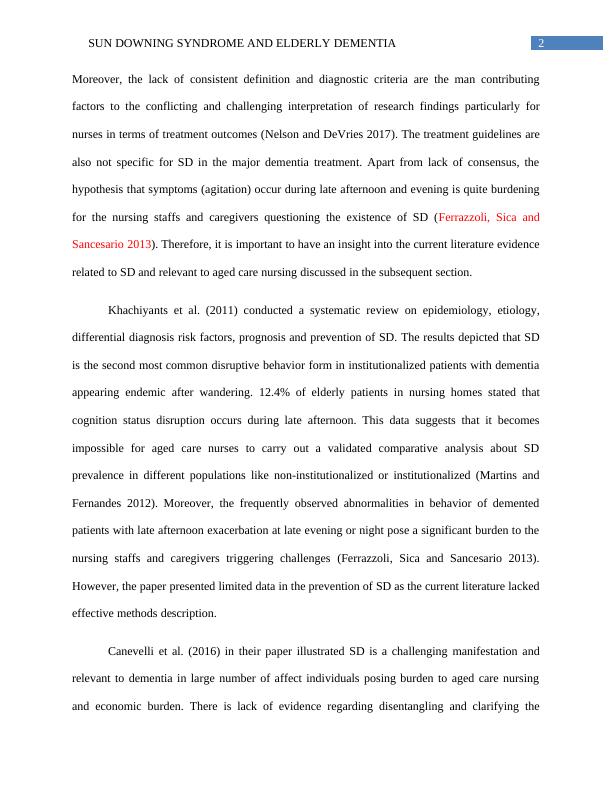Sun Downing Syndrome and Elderly Dementia
7 Pages1730 Words110 Views
Added on 2020-04-13
Sun Downing Syndrome and Elderly Dementia
Added on 2020-04-13
ShareRelated Documents
Running head: SUN DOWNING SYNDROME AND ELDERLY DEMENTIASun downing syndrome and elderly dementiaName of the StudentName of the UniversityAuthor note

1SUN DOWNING SYNDROME AND ELDERLY DEMENTIASun Downing Syndrome (SD) is a highly prevalent condition that is associated withindividuals with dementia occurs during the middle stages of mixed dementia or Alzheimer’sdisease (Ferrazzoli, Sica and Sancesario 2013). This is called ‘late-day confusion’ creatingagitation and confusion in the late afternoon and evening being less pronounced during the day.There is no exact reason for this behaviour although it is aggravated due to low lighting, fatigue,increased shadows, internal clocks disruption, infections or separating reality from dreams. It issyndrome associated with nocturnal delirium and form of Behavioural and PsychologicalSymptoms of Dementia (BPSD) affecting around 10% to 25% patients in nursing care residentsand 66% dementia dwelling patients (Yevchak, Steis and Evans 2012). Structuring ofenvironment, meeting psychological and physical needs, scheduled activities of daily living,enhanced social activities and preventing loneliness can reduce SD symptoms (Venturelli et al.2016). It is hard to distinguish sundowning as it has an unclear diagnostic criteria and definition.Therefore, the following essay involves the discussion of sundowning syndrome as a nursingissue and critical appraisal of current evidence associated with it. During my clinical placement, I was working at dementia ward in nursing home where Iwas assigned to look after sun downing syndrome patients with dementia. I found it challengingto look after them during my shift and planned to research syndrome. A literature review wasconducted to explore this condition, describing what it is, why it occurs and its prevalence withproper management and treatment in reducing agitation being a major nursing issue. Sundowning has entered the common parlance of aged care nursing and dementiacaregivers questioning whether it is common syndrome as assumed associated with dementedindividuals or not (Ferrazzoli, Sica and Sancesario 2013). However, it is not a formal form ofpsychiatric diagnosis in the Diagnostic and Statistical Manual of Mental Disorders (DSM-MD).

2SUN DOWNING SYNDROME AND ELDERLY DEMENTIAMoreover, the lack of consistent definition and diagnostic criteria are the man contributingfactors to the conflicting and challenging interpretation of research findings particularly fornurses in terms of treatment outcomes (Nelson and DeVries 2017). The treatment guidelines arealso not specific for SD in the major dementia treatment. Apart from lack of consensus, thehypothesis that symptoms (agitation) occur during late afternoon and evening is quite burdeningfor the nursing staffs and caregivers questioning the existence of SD (Ferrazzoli, Sica andSancesario 2013). Therefore, it is important to have an insight into the current literature evidencerelated to SD and relevant to aged care nursing discussed in the subsequent section. Khachiyants et al. (2011) conducted a systematic review on epidemiology, etiology,differential diagnosis risk factors, prognosis and prevention of SD. The results depicted that SDis the second most common disruptive behavior form in institutionalized patients with dementiaappearing endemic after wandering. 12.4% of elderly patients in nursing homes stated thatcognition status disruption occurs during late afternoon. This data suggests that it becomesimpossible for aged care nurses to carry out a validated comparative analysis about SDprevalence in different populations like non-institutionalized or institutionalized (Martins andFernandes 2012). Moreover, the frequently observed abnormalities in behavior of dementedpatients with late afternoon exacerbation at late evening or night pose a significant burden to thenursing staffs and caregivers triggering challenges (Ferrazzoli, Sica and Sancesario 2013).However, the paper presented limited data in the prevention of SD as the current literature lackedeffective methods description. Canevelli et al. (2016) in their paper illustrated SD is a challenging manifestation andrelevant to dementia in large number of affect individuals posing burden to aged care nursingand economic burden. There is lack of evidence regarding disentangling and clarifying the

End of preview
Want to access all the pages? Upload your documents or become a member.
